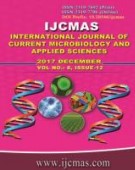


 National Academy of Agricultural Sciences (NAAS)
National Academy of Agricultural Sciences (NAAS)

|
PRINT ISSN : 2319-7692
Online ISSN : 2319-7706 Issues : 12 per year Publisher : Excellent Publishers Email : editorijcmas@gmail.com / submit@ijcmas.com Editor-in-chief: Dr.M.Prakash Index Copernicus ICV 2018: 95.39 NAAS RATING 2020: 5.38 |
Nature and magnitude of genotype x environment interaction (GEI) was studied among 12 Basmati rice genotypes across four environments viz., normal transplanting, late transplanting, system of rice intensification (SRI) and direct seeded rice (DSR) during Kharif 2016 using GGE biplot analysis. Genotype x management interaction followed by environment was found to be the major source of variation and the first two principal components (PCs) of GGE biplot accounted for more than 70% of variation for yield. As per AMMI analysis, discriminating ability of E2 and E3 was found to be closest to the ideal environment and G5 and G10 are top performing in E2 and E3 and G6 and G8 are better performing in E4 and E1 respectively while, stability mean of genotypes revealed that G4 is most stable cultivar and G8, G9 and G6 are the most unstable cultivars. ‘Which-won-where’ analysis revealed two mega environments (ME) among the test locations, with ME1 represented by 2 locations E2 and E3 with G10 as winning genotype and ME2 with 2 locations E1 and E4 with G8 as another winning genotype.
 |
 |
 |
 |
 |